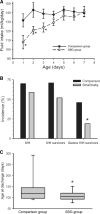Development of a small baby unit to improve outcomes for the extremely premature infant
- PMID: 33712714
- PMCID: PMC7952830
- DOI: 10.1038/s41372-021-00984-0
Development of a small baby unit to improve outcomes for the extremely premature infant
Abstract
Survival and outcomes for extremely premature (EP) infants have improved and even infants born at 23 and 24 weeks that were previously considered non-viable are now routinely surviving. This review describes our particular institution's basis for and process of creating and sustaining a small baby program for a quaternary, referral-based neonatal intensive care unit. Through multi-disciplinary collaboration, small baby guidelines were developed that established uniform care and optimized evidence-based practice for the care of this unique patient population. A focus on parent-centered care while removing noxious stimuli for the patient has improved neurodevelopmental outcomes. Data collection, quality improvement, and ongoing research are incorporated in the small baby program to establish and sustain best practices and outcomes for the EP patient. Through the establishment of a small baby unit, we have improved survival, decreased short-term morbidities, and improved neurodevelopmental outcomes for the EP infant in our region.
© 2021. The Author(s), under exclusive licence to Springer Nature America, Inc. part of Springer Nature.
Conflict of interest statement
OF, LDN, and EGS have no conflicts of interest to declare. KMR is a Board Member of the Children’s Hospital Neonatal Consortium and receives financial compensation in this role.
Figures




References
Publication types
MeSH terms
LinkOut - more resources
Full Text Sources
Other Literature Sources

